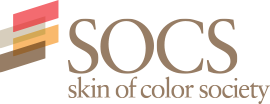Psoriasis
Samantha Pollock, MD, Mayra Maymone, MD and Neelam Vashi, MD
What is Psoriasis?
Psoriasis is a common chronic skin disease that affects 1-11% of the world’s population1 and is found more commonly in Caucasians than in African and Hispanic ethnicities.2,3 It usually presents as thickened, red areas of skin, with an overlying crust or “silvery scale” present on the scalp, elbows, knees, and back.4 The lesions can be itchy, causing many individuals to scratch or remove the overlying scale which can cause small bleeds as if it is a scab.5 In people with skin of color, the redness is less pronounced, and psoriasis may appear as “violet” or darkened areas of skin that are thicker than the surrounding skin with more scales, known as “post-inflammatory hyperpigmentation.” 5,6 The individual lesions may cover more body area in African Americans. Psoriasis can begin at any age, most commonly by age 30, although the disease is less common in children than in adults.2
There are several types of psoriasis, some of which are described below:
Chronic plaque psoriasis
This is the most common variant, presenting as symmetrically distributed lesions on the elbows, knees, and scalp. The lesions are red or violet in color, with a thick silvery scale overlying, creating a sharply defined border between the lesion and the surrounding normal skin. These plaques can range from 1 to 10cm in diameter.5,6
Guttate psoriasis
These lesions are small, usually less than 1 cm in diameter, and appear abruptly as papules on the back, arms, and thighs. Guttate psoriasis is common in a child or young adult and is linked to recent infections with Streptococcus, most commonly, pharyngitis.6,7
Nail psoriasis
Sometimes people with psoriasis will develop nail problems, which may be the only manifestation of the disease.8 Nail pits develop, presenting as tiny pin pricks on the nail. In addition, the nails may become thick and crumbling, and develop a brown color known as “oil spots.” 8,9
Inverse psoriasis
Inverse psoriasis is called “inverse” as it presents on less visible areas of skin, rather than on the extensor surfaces. It can be seen under the armpits, buttocks folds, groin, and area under the breasts. Due to its atypical presentation, this form can be misdiagnosed as a fungal or bacterial infection.4
Psoriatic arthritis
Although psoriasis is primarily a disease of the skin, among 7-48% of patients have associated arthritis.10 Join pain, joint stiffness, and back pain is common, and arthritis is seen in the hands and knees.4 Nail psoriasis is a common finding in individuals with psoriatic arthritis.10
What causes Psoriasis?
The cause of psoriasis is not fully understood, but is thought to be due a dysregulation in the immune system, when immune cells such as T lymphocytes that release inflammatory signals into the skin that initiate the disease. The epidermis (the outer layer of skin) rapidly proliferates, and the immune cells prevent this layer from shedding properly. This causes thickening of the skin and scales which are composed of accumulated dead skin cells. There is an overexpression of different types of proteins found in skin, known as keratin, that are seen in reactive and healing skin.6 Psoriasis has been found to have a genetic component as well, as approximately 40% of patients with psoriasis have a family member with the disease.11 Several genes have been identified that increase the susceptibility of psoriasis, with different genes among different ethnicities. Despite the genetic factors, there is no DNA test to diagnosis psoriasis. 4,5,6,11 Environmental factors also play a role. Certain triggers, such as bacterial infections, stressful life events, dietary factors, trauma, and the weather have been shown to contribute to the development of psoriasis.4
How do I know if I have Psoriasis?
Psoriasis is usually diagnosed clinically. Dermatologists can examine the skin and can also obtain a skin biopsy to rule out other diseases.
How is Psoriasis Treated?
There are many treatments available that can help the disease depending on both the type and severity. Psoriasis cannot be cured, but you can manage the symptoms with medication. Moisturization, with petroleum jelly or thick creams, is key to keeping the skin soft and moist in order to minimize itching.12 Certain medications such as calcipotriene or calcitriol are related to Vitamin D and have been shown to be effective in slowing the growth of the epidermal skin cells.12,13 A Vitamin A derivative, tazarotene, can also be prescribed by a dermatologist for mild or limited disease.5,14 A dermatologist may also prescribe a topical corticosteroid to be applied to the skin to reduce inflammation. Steroids are often used twice per day in the beginning of treatment and applied with decreasing frequency as psoriasis improves.14 If topical agents are not sufficient, phototherapy with ultraviolet light B, UVA, or combination treatments can be effective.5 As psoriasis is an immune-related disease, certain biologic agents or immunotherapy regimens can be given as well.15
Download Spanish translation.
Descarga traducción en español.
Additional Resources
American Academy of Dermatology: Psoriasis
References
- Parisi R, Symmons DP, Griffiths CE, et al. Global epidemiology of psoriasis: a systematic review of incidence and prevalence. J Invest Dermatol 2013; 133:377.
- Rachakonda Td, Schupp CW, Armstrong AW. Psoriasis prevalence among adults in the United States. J Am Acad Dermatol. 2014; 70(3): 512-6.
- Michalek IM, Loring B, John SM. A systematic review of worldwide epidemiology of psoriasis. J Eur Acad Dermatol Venereol 2017; 31:205.
- Schön MP, Boehncke WH. Psoriasis. N Engl J Med 2005; 352:1899.
- Kaufman, B., & Alexis, A. (2017). Psoriasis in Skin of Color: Insights into the Epidemiology, Clinical Presentation, Genetics, Quality-of-Life Impact, and Treatment of Psoriasis in Non-White Racial/Ethnic Groups. American Journal of Clinical Dermatology, 19(3), 405-423.
- Nestle FO, Kaplan DH, Barker J. Psoriasis. N Engl J Med 2009; 361:496.
- Ko HC, Jwa SW, Song M, et al. Clinical course of guttate psoriasis: long-term follow-up study. J Dermatol 2010; 37:894.
- Klaassen KM, van de Kerkhof PC, Pasch MC. Nail psoriasis: a questionnaire-based survey. Br J Dermatol 2013; 169:314.
- van der Velden HM, Klaassen KM, van de Kerkhof PC, Pasch MC. Fingernail psoriasis reconsidered: a case-control study. J Am Acad Dermatol 2013; 69:245.
- Ibrahim G, Waxman R, Helliwell PS. The prevalence of psoriatic arthritis in people with psoriasis. Arthritis Rheum 2009; 61:1373.
- Farber E, Nall M. Epidemiology: natural history and genetics. In: Roenigk H, Maibach H, editors. Psoriasis. New York: Marcel Dekker; 1998. P. 107-58.
- Menter A, Griffiths CE. Current and future management of psoriasis. Lancet 2007; 370:272.
- Armstrong AW, Siegel MP, Bagel J, et al. From the Medical Board of the National Psoriasis Foundation: Treatment targets for plaque psoriasis. J Am Acad Dermatol 2017; 76:290.
- Samarasekera EJ, Sawyer L, Wonderling D, et al. Topical therapies for the treatment of plaque psoriasis: systematic review and network meta-analyses. Br J Dermatol 2013; 168:954.
- Boehncke WH, Prinz J, Gottlieb AB. Biologic therapies for psoriasis. A systematic review. J Rheumatol 2006; 33:1447.
Education Video Library

Cutis Journal
Read published peer-reviewed articles written your by Skin of Color Society members

Did You Know
Skin of color patients comprise the majority in California, New Mexico and Texas…and soon will be the majority in Arizona, Nevada, Georgia, New York and Florida.
By 2042, more than 50% of the US population will have skin of color.




